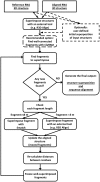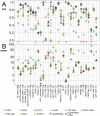SupeRNAlign: a new tool for flexible superposition of homologous RNA structures and inference of accurate structure-based sequence alignments
- PMID: 28934487
- PMCID: PMC5766185
- DOI: 10.1093/nar/gkx631
SupeRNAlign: a new tool for flexible superposition of homologous RNA structures and inference of accurate structure-based sequence alignments
Abstract
RNA has been found to play an ever-increasing role in a variety of biological processes. The function of most non-coding RNA molecules depends on their structure. Comparing and classifying macromolecular 3D structures is of crucial importance for structure-based function inference and it is used in the characterization of functional motifs and in structure prediction by comparative modeling. However, compared to the numerous methods for protein structure superposition, there are few tools dedicated to the superimposing of RNA 3D structures. Here, we present SupeRNAlign (v1.3.1), a new method for flexible superposition of RNA 3D structures, and SupeRNAlign-Coffee-a workflow that combines SupeRNAlign with T-Coffee for inferring structure-based sequence alignments. The methods have been benchmarked with eight other methods for RNA structural superposition and alignment. The benchmark included 151 structures from 32 RNA families (with a total of 1734 pairwise superpositions). The accuracy of superpositions was assessed by comparing structure-based sequence alignments to the reference alignments from the Rfam database. SupeRNAlign and SupeRNAlign-Coffee achieved significantly higher scores than most of the benchmarked methods: SupeRNAlign generated the most accurate sequence alignments among the structure superposition methods, and SupeRNAlign-Coffee performed best among the sequence alignment methods.
© The Author(s) 2017. Published by Oxford University Press on behalf of Nucleic Acids Research.
Figures




Similar articles
-
ARTEMIS: a method for topology-independent superposition of RNA 3D structures and structure-based sequence alignment.Nucleic Acids Res. 2024 Oct 14;52(18):10850-10861. doi: 10.1093/nar/gkae758. Nucleic Acids Res. 2024. PMID: 39258540 Free PMC article.
-
SARA-Coffee web server, a tool for the computation of RNA sequence and structure multiple alignments.Nucleic Acids Res. 2014 Jul;42(Web Server issue):W356-60. doi: 10.1093/nar/gku459. Epub 2014 Jun 27. Nucleic Acids Res. 2014. PMID: 24972831 Free PMC article.
-
MARNA: multiple alignment and consensus structure prediction of RNAs based on sequence structure comparisons.Bioinformatics. 2005 Aug 15;21(16):3352-9. doi: 10.1093/bioinformatics/bti550. Epub 2005 Jun 21. Bioinformatics. 2005. PMID: 15972285
-
Energy-based RNA consensus secondary structure prediction in multiple sequence alignments.Methods Mol Biol. 2014;1097:125-41. doi: 10.1007/978-1-62703-709-9_7. Methods Mol Biol. 2014. PMID: 24639158 Review.
-
The art of editing RNA structural alignments.Methods Mol Biol. 2014;1097:379-94. doi: 10.1007/978-1-62703-709-9_17. Methods Mol Biol. 2014. PMID: 24639168 Review.
Cited by
-
RMalign: an RNA structural alignment tool based on a novel scoring function RMscore.BMC Genomics. 2019 Apr 8;20(1):276. doi: 10.1186/s12864-019-5631-3. BMC Genomics. 2019. PMID: 30961545 Free PMC article.
-
A comprehensive survey of long-range tertiary interactions and motifs in non-coding RNA structures.Nucleic Acids Res. 2023 Sep 8;51(16):8367-8382. doi: 10.1093/nar/gkad605. Nucleic Acids Res. 2023. PMID: 37471030 Free PMC article.
-
ARTEMIS: a method for topology-independent superposition of RNA 3D structures and structure-based sequence alignment.Nucleic Acids Res. 2024 Oct 14;52(18):10850-10861. doi: 10.1093/nar/gkae758. Nucleic Acids Res. 2024. PMID: 39258540 Free PMC article.
-
RNAconTest: comparing tools for noncoding RNA multiple sequence alignment based on structural consistency.RNA. 2020 May;26(5):531-540. doi: 10.1261/rna.073015.119. Epub 2020 Jan 31. RNA. 2020. PMID: 32005745 Free PMC article.
-
1D2DSimScore: A novel method for comparing contacts in biomacromolecules and their complexes.Protein Sci. 2023 Jan;32(1):e4503. doi: 10.1002/pro.4503. Protein Sci. 2023. PMID: 36369832 Free PMC article.
References
-
- Murzin A.G., Brenner S.E., Hubbard T., Chothia C.. SCOP: a structural classification of proteins database for the investigation of sequences and structures. J. Mol. Biol. 1995; 247:536–540. - PubMed
-
- Orengo C.A., Michie A.D., Jones S., Jones D.T., Swindells M.B., Thornton J.M.. CATH–a hierarchic classification of protein domain structures. Structure. 1997; 5:1093–1108. - PubMed
-
- Holm L., Sander C.. Dali: a network tool for protein structure comparison. Trends Biochem. Sci. 1995; 20:478–480. - PubMed
Publication types
MeSH terms
Substances
LinkOut - more resources
Full Text Sources
Other Literature Sources

